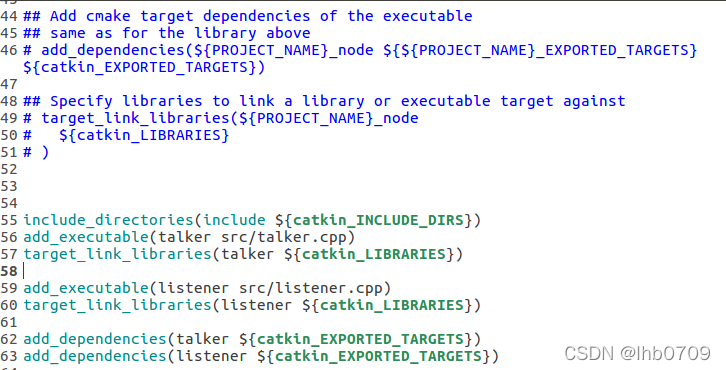本文从下面博客改编而来
ROS编程入门教程(全过程示例代码)_lhb0709的专栏-CSDN博客
首先创建工作空间(working space)
mkdir -p ~/catkin_ws/src
cd ~/catkin_ws/src
catkin_init_workspace创建功能包pkg ,
catkin_create_pkg beginner_tutorials std_msgs rospy roscpp
创建源代码目录和源码cpp
mkdir -p ~/catkin_ws/src/beginner_tutorials/src![]()
?talker.cpp?
#include "ros/ros.h"
#include "std_msgs/String.h"
#include <sstream>
#include <string>
#include "geometry_msgs/Twist.h"
/**
* This tutorial demonstrates simple sending of messages over the ROS system.
*/
int main(int argc, char **argv)
{
/**
* The ros::init() function needs to see argc and argv so that it can perform
* any ROS arguments and name remapping that were provided at the command line. For programmatic
* remappings you can use a different version of init() which takes remappings
* directly, but for most command-line programs, passing argc and argv is the easiest
* way to do it. The third argument to init() is the name of the node.
*
* You must call one of the versions of ros::init() before using any other
* part of the ROS system.
*/
ros::init(argc, argv, "talker");
/**
* NodeHandle is the main access point to communications with the ROS system.
* The first NodeHandle constructed will fully initialize this node, and the last
* NodeHandle destructed will close down the node.
*/
ros::NodeHandle n;
/**
* The advertise() function is how you tell ROS that you want to
* publish on a given topic name. This invokes a call to the ROS
* master node, which keeps a registry of who is publishing and who
* is subscribing. After this advertise() call is made, the master
* node will notify anyone who is trying to subscribe to this topic name,
* and they will in turn negotiate a peer-to-peer connection with this
* node. advertise() returns a Publisher object which allows you to
* publish messages on that topic through a call to publish(). Once
* all copies of the returned Publisher object are destroyed, the topic
* will be automatically unadvertised.
*
* The second parameter to advertise() is the size of the message queue
* used for publishing messages. If messages are published more quickly
* than we can send them, the number here specifies how many messages to
* buffer up before throwing some away.
*/
ros::Publisher chatter_pub = n.advertise<std_msgs::String>("chatter", 1000);
ros::Publisher turtle1_pub=n.advertise<geometry_msgs::Twist>("/turtle1/cmd_vel",10); //topic
ros::Rate loop_rate(10);
/**
* A count of how many messages we have sent. This is used to create
* a unique string for each message.
*/
int count = 1;
while (ros::ok())
{
/**
* This is a message object. You stuff it with data, and then publish it.
*/
std_msgs::String msg;
std::stringstream ss;
ss << "hello world from talker" << count;
msg.data = ss.str();
ROS_INFO("%s", msg.data.c_str());
/**
* The publish() function is how you send messages. The parameter
* is the message object. The type of this object must agree with the type
* given as a template parameter to the advertise<>() call, as was done
* in the constructor above.
*/
chatter_pub.publish(msg);
geometry_msgs::Twist turtle_msg;
turtle_msg.linear.x = 1.0; //前后(+ -) m/s
turtle_msg.linear.y = 0.0; //左右(+-) m/s
turtle_msg.linear.z = 0.0;
turtle_msg.angular.x = 0;
turtle_msg.angular.y = 0;
turtle_msg.angular.z = 0.99; //机器人的自转速度,+左转,-右转,单位是rad/s
turtle1_pub.publish(turtle_msg);
ROS_INFO("publish turtle run command[%0.2f m/s,%0.2f rad/s]", turtle_msg.linear.x, turtle_msg.angular.z);
ros::spinOnce();
loop_rate.sleep();
++count;
}
return 0;
}
?listener.cpp?
#include "ros/ros.h"
#include "std_msgs/String.h"
#include "turtlesim/Pose.h"
/**
* This tutorial demonstrates simple receipt of messages over the ROS system.
*/
void chatterCallback(const std_msgs::String::ConstPtr& msg)
{
ROS_INFO("I heard: [%s]", msg->data.c_str());
}
void turtleCallback(const turtlesim::Pose::ConstPtr& msg)
{
ROS_INFO("turtle pose :x=%.2f,y=%.2f,linear=%.2f,angular=%.2f,theta=%.2f",
msg->x,msg->y,msg->linear_velocity,msg->angular_velocity,msg->theta);
}
int main(int argc, char **argv)
{
/**
* The ros::init() function needs to see argc and argv so that it can perform
* any ROS arguments and name remapping that were provided at the command line. For programmatic
* remappings you can use a different version of init() which takes remappings
* directly, but for most command-line programs, passing argc and argv is the easiest
* way to do it. The third argument to init() is the name of the node.
*
* You must call one of the versions of ros::init() before using any other
* part of the ROS system.
*/
ros::init(argc, argv, "listener");
/**
* NodeHandle is the main access point to communications with the ROS system.
* The first NodeHandle constructed will fully initialize this node, and the last
* NodeHandle destructed will close down the node.
*/
ros::NodeHandle n;
/**
* The subscribe() call is how you tell ROS that you want to receive messages
* on a given topic. This invokes a call to the ROS
* master node, which keeps a registry of who is publishing and who
* is subscribing. Messages are passed to a callback function, here
* called chatterCallback. subscribe() returns a Subscriber object that you
* must hold on to until you want to unsubscribe. When all copies of the Subscriber
* object go out of scope, this callback will automatically be unsubscribed from
* this topic.
*
* The second parameter to the subscribe() function is the size of the message
* queue. If messages are arriving faster than they are being processed, this
* is the number of messages that will be buffered up before beginning to throw
* away the oldest ones.
*/
ros::Subscriber sub = n.subscribe("chatter", 1000, chatterCallback);
ros::Subscriber turtle_sub = n.subscribe<turtlesim::Pose>("/turtle1/pose", 100, turtleCallback);
/**
* ros::spin() will enter a loop, pumping callbacks. With this version, all
* callbacks will be called from within this thread (the main one). ros::spin()
* will exit when Ctrl-C is pressed, or the node is shutdown by the master.
*/
ros::MultiThreadedSpinner spinner(4); // Use 4 threads
ros::spin();
return 0;
}?
程序包(~/catkin_ws/src/beginner_tutorials)的?CMakeLists.txt文件,修改如下(最后两行,要不要都行)

?返回工作空间编译
catkin_make 启动小乌龟
roscore
rosrun turtlesim turtlesim_node同样在工作空间分别开启两个控制台分别启动talker 和?listener
source ./devel/setup.bash
rosrun beginner_tutorials talker ?
source ./devel/setup.bash
rosrun beginner_tutorials listener?
测试效果如下图,

?
?
实现原理:
启动手动控制小乌龟游戏?,方法见
ROS 安装教程Ubuntu16.04(2022年最新)_lhb0709的专栏-CSDN博客

teleop_turtle? ? 是虚拟机键盘节点
turtlesim? ? 是小乌龟节点
/turtle1/cmd_vel 是topic
依次使用命令查看turtle1/cmd_vel的类型和数据结构(代码中要用)
rostopic list
rostopic info /turtle1/cmd_vel
rosmsg info geometry_msgs/Twist

?依次使用命令查看turtle1/pose的类型和数据结构(代码中要用)
rostopic list
rostopic info /turtle1/cmd_vel
rosmsg info geometry_msgs/Twist
?
?Python 实现的位姿显示代码参考,会python和QT一看就懂
ROS实操入门系列(二)操控小乌龟时,监控行走的路线(第二章补充Topic干货!) - 古月居 (guyuehome.com)